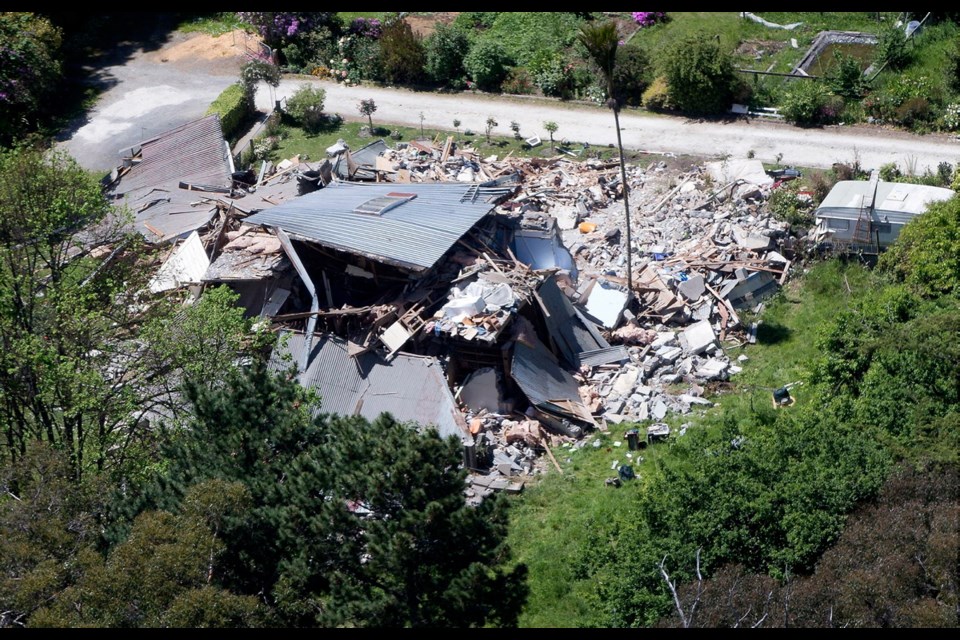The 7.8-magnitude earthquake in New Zealand that killed two people and triggered a small tsunami and massive rock slides should serve as a wakeup call for Vancouver Islanders, say earthquake experts.
New Zealand’s South Island was rocked by hundreds of aftershocks, including a 6.3-magnitude tremor, after the first quake struck just after midnight on Monday. Residents in the major cities of Christchurch and Wellington felt shaking for several minutes.
East Sooke resident Karen Laundry said she and her husband, David, are living in Christchurch, about 93 kilometres south of the earthquake’s epicentre near the town of Kaikoura, which remains cut off by road due to massive landslides.
“David and I woke with the shaking, just past midnight,” she said. “It was long and rolling, like being on a ship.”
She said she checked on her family, drank some tea and went back to sleep.
“In the morning I knew all the people, and my workmates, who lived by the beach would not have slept due to evacuation from tsunami warnings,” Laundry said.
New Zealand and Vancouver Island are situated in the Ring of Fire, a 40,000-kilometre horseshoe-shaped area of ocean trenches, shifting tectonic plates and volcanoes where 90 per cent of the world's earthquakes take place.
Experts have predicted that British Columbia has a one-in-three chance of being rocked by a major earthquake in the next 50 years.
Rob Johns, manager of emergency planning at University of Victoria, said Monday’s earthquake was long-lasting and rolling, very different from the sharp, intensely localized 6.3-magnitude earthquake that destroyed much of downtown Christchurch in 2011 and killed 185 people.
The rolling earthquake, similar to what Vancouver Island is likely to see if there was a quake along the Cascadia subduction zone, is spread out over a larger area and has the potential to trigger a tsunami and landslides up and down the coast.
A crustal earthquake, the aftermath of which Johns witnessed when he visited Christchurch two weeks after the disaster, causes more destruction in a concentrated area, he explained.
“So in a way we’re seeing two different kinds of earthquakes in New Zealand and two different effects,” said Johns. Any major earthquake around the world will be studied by sa���ʴ�ý seismologists who will try to learn as much as possible about what happened, he said.
“Christchurch does draw a great parallel for us [in Greater Victoria],” said Maegan Thompson, emergency program officer with Saanich Fire, pointing to similarities in the population size, building make-up and urban density.
One thing emergency responders have learned by studying major earthquakes in countries like New Zealand and Japan, Thompson said, is that response is short but recovery is long.
“Response is a matter of days, 10 days at the most depending on the event,” she said. However, it can take years for economic recovery, emotional recovery and infrastructure rebuilding, Thompson said.
Taimi Mulder, seismologist with Geological Survey sa���ʴ�ý, said the earthquake in New Zealand should shake sa���ʴ�ý residents out of complacency toward proper earthquake preparedness.
“This is a big chance for us to be prepared, it’s a very good reminder, along with the Great sa���ʴ�ý Shakeout that we practised last month,” Mulder said. “Look at the types of damage you see on television from those earthquakes and image that happening here and prepare your home accordingly.”
The government has promised to carry out seismic upgrades on 339 schools across the province. To date, 115 schools have been completed, but the government has pushed back its deadline for completion to 2025 for most schools across sa���ʴ�ý and to 2030 for Vancouver.
The Greater Victoria school district has completed 15 of its 24 seismic projects. Four schools are currently under construction.
“I think those are important measures we’ve been taking to retrofit these important places like schools and we should be retrofitting hospitals and important historical buildings as well,” Mulder said.



